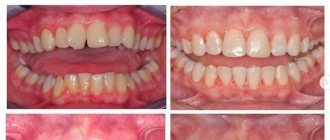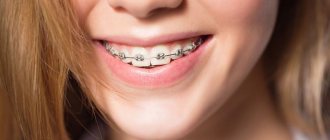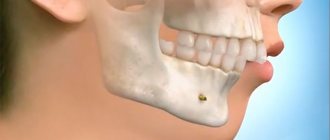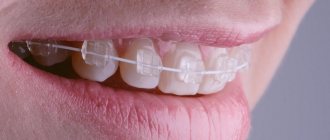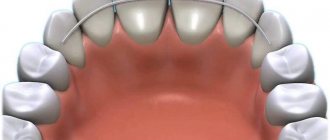3708
One of the most common and effective ways to correct bite defects is braces.
These structures are attached to each tooth and worn throughout the treatment period. An important role in the course of treatment is played by the correctness and reliability of fixation of the braces' locks.
Preparing for positioning
Installation of braces requires a preparatory stage. After an initial consultation with an orthodontist, the patient will need to carefully prepare the oral cavity.
Braces are installed only on healthy elements of the jaw arch.
Basic steps in preparation:
- Treatment of carious lesions. It is necessary to detect and treat all existing sites of caries development, even the smallest ones;
- Checking old fillings. If there are seals that were installed a long time ago, you need to check their strength and replace if necessary;
- Periodontal diseases. The mucous membrane of the oral cavity must be absolutely healthy. Even the most minor inflammations can worsen after the installation of braces;
- Remineralization. If there are areas of thinning enamel, increased sensitivity or cracks on the teeth, a remineralization procedure should be performed. It will help strengthen tooth enamel and avoid the development of certain diseases during orthodontic treatment.
Complete sanitation of the oral cavity is a prerequisite that must be completed first before installing braces.
Depending on the initial condition of the oral cavity, the preparation stage may take several months.
During the treatment period, panoramic photographs of the jaws . Based on them, the doctor draws up a treatment plan and determines where to fix the locks.
Immediately before fixing braces, it is necessary to have your teeth professionally cleaned . During this procedure, the surface of the teeth is cleaned, tartar and plaque are removed.
This is done to ensure that the surface of the teeth is absolutely clean, and when gluing the structure nothing interferes with the strong adhesion of the surfaces.
Why is it undesirable to undergo an MRI with braces on your teeth?
Come here if you are interested in what to do if a person accidentally swallows a brace.
At this address https://orto-info.ru/sistemyi-vyiravnivaniya-zubov/breketyi/nuzhno-li-udalyat-pri-ustanovke.html we will answer the question: is it necessary to remove teeth when installing braces.
Stage 2: Treatment Plan
After diagnosis, the orthodontist needs about a week to analyze all the material, make calculations and draw up an individual treatment plan.
There can be one or several treatment plans. Each of them may have its own characteristics, pros and cons. The orthodontist most often voices the treatment plan that he is inclined towards and considers the most optimal in this case.
The patient can choose any of the proposed treatment plans, realizing the difference between them and understanding the doctor’s point of view. After the patient and the doctor have agreed on one of the plans, the choice of braces occurs - this is a strategic issue in which the patient and his attending physician must come to a consensus.
Direct method
After all the preparatory procedures have been completed, the doctor can begin fixing the bracket system. There are two main ways to attach braces to teeth – direct and indirect.
The direct method involves manually gluing clasps onto each tooth. This work is quite painstaking and requires a lot of attention and experience of a specialist.
To some extent, such work can be compared to jewelry. All teeth have different sizes, so the clasps must be precisely selected and glued.
During installation of the structure, the doctor uses tweezers, a clamp, a holder and a positioner. With their help, the orthodontist holds the clasps, measures their exact position in accordance with the marks on the panoramic photographs and fixes them on the teeth.
Sequence of actions for direct installation:
- A retractor is installed;
- A special composition based on orthophosphoric acid is applied to the enamel. It helps make the enamel surface rougher, which creates the most reliable adhesion;
- After 30 seconds, the composition is washed off with water;
- The surface of the teeth is dried;
- A therapeutic composite is applied to the enamel, which creates a protective layer;
- An adhesive composition is prepared (as a rule, it consists of two components);
- Glue is applied to the back of the locks;
- The lock is fixed to each tooth in turn;
- Excess glue is removed;
- After the glue has hardened, a metal arc is inserted and ligatures are attached.
The entire procedure for installing a bracket system takes approximately 1-1.5 hours. Complete hardening of the glue occurs in about a day.
During this period, the patient should take only soft and liquid foods.
The advantages of this method are:
- Accurate installation of locks according to the planned plan;
- Possibility of making adjustments during installation;
- Reliable fastening of locks;
- Prevents food from getting between locks and enamel.
The disadvantages are:
- Takes a long time;
- The patient must remain stationary throughout the entire installation;
- A lot of effort and attention is required from a doctor.
The video shows the process of the direct method of fixing braces.
Features of H4 braces
OrthoClassic constructions are self-ligating. Instead of ligatures, special hooks are used here, with the help of which the arch is fixed to the braces. The system features a Treadlok pad and double-leaf base for maximum durability.
H4 consists of an arch and the plates themselves, which are installed on the teeth. The first is made of elastic material: it is stretched and secured to braces. Then it begins to shrink, returning to its original shape, and, as a result, moving the teeth. The locks with which it is secured can be positioned at any angle. This way you can change the position of your teeth for completely different problems.
Among the main features of H4 braces are:
- miniature plates, making oral care much easier than with traditional braces;
- rounded shape of the elements: they do not scratch the gums and tongue and do not cause inconvenience;
- low profile (the arch is attached closer to the gum): “foreign” elements become less noticeable during a conversation or when smiling;
- use of metal: this reduces the cost of the system and makes it stronger.
H4 is a democratic solution for those who want to correct their bite as quickly as possible, without frequent visits to the orthodontist. These are reliable and high-quality designs that are used for both teenagers and adults.
Indirect installation
Recently, the indirect method of fixing braces has become popular. This method allows you to glue products to all teeth at the same time using a special tray.
The indirect method of fixing braces reduces the time of direct installation, but requires longer preliminary preparation in the laboratory.
What is the preparation:
- Impressions are taken of the patient's jaws , on the basis of which an accurate plaster model is made;
- The location of the locks is marked on the model using reference lines;
- Using burnt sugar or heating the model, the clasps are fixed to the jaw model;
- A special mouthguard is made that accurately follows the contours of the teeth;
- The mouth guard is pressed against the model , thereby transferring the locks onto it.
Installation of the structure to the patient is carried out as follows:
- A retractor is installed;
- Tooth enamel is etched with an orthophosphorus compound;
- After 30 seconds, the solution is washed off;
- The surface of the teeth is dried;
- A protective composite is applied;
- An adhesive is applied to the back of the locks;
- A mouthguard with braces is placed on the jaw;
- After an hour, the mouth guard is removed;
- A metal arc and ligatures are installed.
Among the advantages of this method are:
- Quick installation due to simultaneous gluing to all teeth;
- Comfort for the patient;
- Precision installation helps to avoid unnecessary pain and speeds up the treatment process.
The disadvantages are:
- It is difficult to determine the correct installation point;
- Inability to control the process of fixation on each tooth;
- It is difficult to remove excess glue;
- Long preparation process.
Watch the video to see how braces are installed indirectly.
Advantages of self-ligating braces
The first systems for correcting the position of teeth had ligatures. These are special elastic loops that secure the plates to the arches. They showed effectiveness, but were not aesthetically pleasing or comfortable enough. In addition, the patient was forced to constantly come to the doctor so that he could “adjust” the design.
Unligated systems do not have such loops. Instead, they use clips, with the help of which the arch is fixed to the braces. They are easy to open (in a medical office setting) to change the tension level. In addition, the teeth do not encounter strong resistance, and as a result, their position becomes more natural and physiological.
Let us summarize the advantages of self-ligating structures:
- higher speed of bite correction;
- no need to visit the orthodontist every 30 days (the frequency of visits depends on the treatment program, but, as a rule, you need to come to the clinic no more than once every two months);
- ease of care (caring for braces without ligatures is only a little more difficult than caring for teeth without any fixed structures);
- comfort when wearing (the patient quickly gets used to it, speech and appearance do not change, and you can continue your active social life and work).
Self-ligating systems are convenient, save time, and shorten the period of bite correction.
Thomas Pitts Table
The above methods of installing braces are based on the personal approach of the attending physician. In addition to this approach, a special protocol for fixing orthodontic systems has been developed.
This approach was developed and proposed by the American doctor Thomas Pitts. Pitts positions guarantee rapid correction of malocclusions.
For ease of understanding and use, these rules were translated by Dr. T. Castelanos into numerical parameters taking into account the length of the teeth.
The Pitts system consists of two parts and has the following scheme.
Upper jaw
| GPS-A | 1 | 2 | 3 | 4 | 5 | 6 | 7 |
| 8 | 4 | 4 | 4,5 | 4,5 | 4 | 3 | 3 |
| 9 | 4,5 | 4,5 | 5 | 5 | 4,5 | 3,5 | 3,5 |
| 10 | 5 | 5 | 5,5 | 5,5 | 5 | 4 | 4 |
| 11 | 5 | 5 | 6 | 6 | 5,5 | 4,5 | 4,5 |
Lower jaw
| GPS-A | 1 | 2 | 3 | 4 | 5 | 6 | 7 |
| 9 | 5 | 4,5 | 4,5 | 4 | 3,5 | 2,5 | 2 |
| 10 | 5,5 | 5 | 5 | 4,5 | 4 | 3 | 2 |
| 11 | 6,5 | 5,5 | 5,5 | 5 | 4,5 | 3,5 | 2,5 |
| 12 | 7 | 6 | 6 | 5 | 5,5 | 4 | 2,5 |
The installation location of the brackets is determined according to the following diagram:
- The length of the tooth crown is measured;
- The resulting figure is looked up in the GPS-A column;
- Next is the installation height according to the tooth standard.
This system helps to quickly determine the desired position for fixing braces, reduces installation time and reduces the likelihood of subjective errors.
Why do you need to come to the clinic?
It's simple: the elastic arch stretches and begins to put pressure on the teeth, trying to return to their previous shape. Gradually the teeth shift. You may not see the changes: they are minor and not always noticeable, but they are there. After some time, the arc regains its original shape and the tension disappears. At this moment you need to go to the doctor so that he can replace it with a new, tougher one. It's pretty fast. In this way, the bite is gradually corrected.
Braces can quickly change the position of your teeth – within 1–2 years you will be able to enjoy an even and beautiful smile. But the treatment does not end there: after removing the structure, a new one is installed - retainers. They do not displace anything, but, on the contrary, fix the teeth in one position until the bone tissue, ligaments and muscles are rebuilt. Otherwise, the old bite will return.
Retainers can be removable (for example, a clear mouthguard) or permanent. The first ones are suitable for teenagers and young adults: their adjustment process is much faster, and they need to wear a mouthguard for about 2 years. After the age of 25–30, it is worth installing a fixed structure - a metal arch on the back side of the dentition. It is invisible, does not cause discomfort and does not require special attention. It is enough to take a little more careful care of your oral cavity and visit the dentist once every six months for professional cleaning.
Resilines adhesive system
The most popular adhesive for fixing braces is the Resilience system. Its adhesive is very soft and sticky, ideal for bonding braces. Using the composition, you can fix both metal and sapphire and ceramic products.
The adhesive hardens under the influence of light. Until the moment of illumination, it remains soft, which makes it possible to accurately install the lock.
The adhesive hardens completely when exposed to light. The metal arch can be installed immediately after fixing the locks.
The Resildynes system consists of several drugs. The cost of one set can vary between 10-15 thousand rubles.
The kit includes:
- Adhesive (in a syringe);
- Etching gel (in a syringe);
- Primer;
- Different tips for syringes;
- Palette for mixing components;
- Holder;
- Brush with three attachments of different lengths.
Is it possible to get a tax deduction for installing braces and what is needed for this?
In this publication, read which category of patients can count on having braces installed under compulsory medical insurance.
Here https://orto-info.ru/sistemyi-vyiravnivaniya-zubov/breketyi/ormco.html we will look at Ormco metal braces in detail.
Price issue
In many dental clinics, the cost for installing braces is highlighted as a separate line.
But there are also clinics where the amount for fixing the orthodontic system is included in the total cost of manufacturing the system. On average, this service is estimated at approximately 30% of the total cost of the braces system.
The installation price for products made from different materials will vary. The more expensive the system itself, the more expensive it will cost to install.
| Product material | Direct installation amount, rub. |
| Metal | From 10 000 |
| Ceramics | From 18000 |
| Sapphire | From 25000 |
The direct method is the most common installation method. The indirect method is currently used in a limited number of clinics. This is explained by its novelty and limited experience of specialists.
Due to the need to make a plaster model and special trays with the indirect method, its cost will increase by approximately 6-9 thousand rubles, compared to the direct method for each type of product material.
Comparison of lingual and vestibular constructions
Based on their location in the dental cavity, they are divided into lingual and vestibular systems. The vestibular position on the outer side of the dentition is classic and is used in the vast majority of cases.
Vestibular Mini Diamond
Lingual appliances are installed by patients with the highest aesthetic requirements. Adaptation to internal systems is more difficult compared to vestibular structures. The principle of operation of lingual and vestibular braces is not fundamentally different: in both cases, the arch is straightened and exerts a force on the braces, leading to the movement of teeth. If there is excessive crowding, the use of a lingual system is not recommended. The duration of treatment on the lingual structure is slightly longer than on the vestibular one. The patient sometimes experiences additional discomfort due to the interaction of the tongue with the brace system.
lingual braces STb
Useful tips
Correcting a bite with braces can take a long period of time. The speed and result of correction of defects depends on how accurately the patient follows all the doctor’s recommendations.
For the first time after fixing the orthodontic system, the patient should avoid solid foods and increased load on the jaws. Preference should be given to soft or liquid foods.
In the future, you must follow these recommendations:
- Visit your doctor regularly. This is necessary to assess the condition, adjust the pressure on the teeth, change ligatures and make the necessary adjustments;
- Careful oral hygiene. It is necessary to brush your teeth several times a day, after eating food. If there are no conditions to brush your teeth, you must rinse your mouth thoroughly;
- Use additional hygiene products (irrigator, floss, brush, etc.);
- Adhere to a special diet. The patient should exclude foods that are too hard, sticky or tough from the diet;
- Carry out periodic professional teeth cleaning;
- Eliminate bad habits.
Following these recommendations will help speed up the treatment process and will also reduce the likelihood of parts of the system coming off or being damaged.
Price
Manufacturing and installation of braces, the price of the work directly depends on the material and complexity of installing the system, for example, metal ones will cost at least 10,000 rubles, ceramic ones - from 18 thousand, and sapphire ones - from 25 thousand.
Adviсe
| Click to sign up for a FREE consultation |
In order to achieve the required result within the time specified by the dentist, you should strictly adhere to the doctor’s recommendations:
- do not take solid food for the first few days;
- systematically visit your doctor to correct the position of braces and sanitize the oral cavity;
- use additional personal hygiene products at home;
- to refuse from bad habits.
By adhering to these simple rules, you will speed up the correction process and reduce the risk of the locks peeling off from the enamel.



